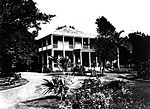YWCA Building (Honolulu, Hawaii)

The YWCA Building at 1040 Richards Street, Honolulu, Hawaii, popularly called the Richards Street Y, is now officially named Laniākea, which means 'open skies' or 'wide horizons' in the Hawaiian language. It was designed by San Francisco architect Julia Morgan, who considered it one of her favorites. The building consists of two large units which are connected by a two-story loggia. The main building is three stories high and faces Richards St. with a frontage of 165 feet. The second unit, which is directly in the rear of the first, is somewhat smaller, being two stories high with a large basement.In the area between the buildings on the mauka side is the spacious swimming pool, 31 by 61 feet. On the makai side of the loggia is a court which can be used for parties and dining. Entrance from the loggia to the rear building is directly into the Elizabeth Fuller Memorial Hall. Ms. Fuller was a charter member of the Hawaiian Girls Club of the YWCA and one of the oldest members of the organization. She died in India while a member of a Hawaiian group of entertainers. In her memory, the club raised $1,000 toward the hall, which the YWCA named after her. At the makai end of the rear building is a restaurant, Cafe Julia, named after the architect.
Excerpt from the Wikipedia article YWCA Building (Honolulu, Hawaii) (License: CC BY-SA 3.0, Authors, Images).YWCA Building (Honolulu, Hawaii)
Bethel Street, Honolulu Chinatown
Geographical coordinates (GPS) Address Nearby Places Show on map
Geographical coordinates (GPS)
| Latitude | Longitude |
|---|---|
| N 21.310555555556 ° | E -157.86083333333 ° |
Address
Hawaii Building
Bethel Street
96808 Honolulu, Chinatown
Hawaii, United States
Open on Google Maps








